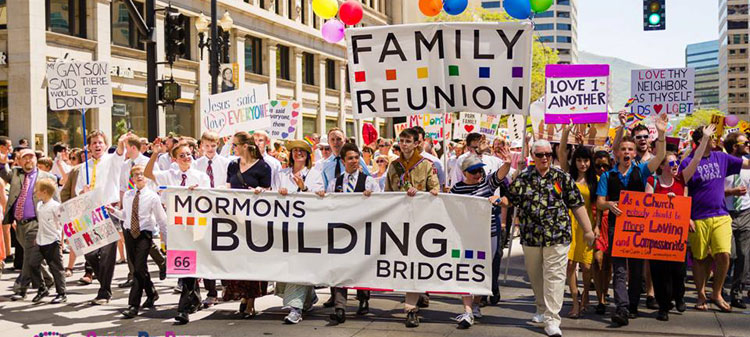Salt Lake City Utah, USA
Mormons Building Bridges is a decentralized grassroots group based in Utah that are composed primarily of active and faithful members of The Church of Jesus Christ of Latter-day Saints (LDS Church) who seek to improve the attitudes between members of the LDS Church and the LGBT community.
Regardless, teenagers need support, even absent sexuality issues, and families and church congregations can be critically valuable environments, experts said.Research shows religious affiliation generally lowers suicide risks, though it also is normal for believing LGBT youth to struggle to square their realization of same-sex attraction with their religious beliefs. Supportive messages are crucial. The possibility of self-harming behavior more than doubles each time an LGBT youth is hurt physically or verbally.Parents and families can provide healthy, constructive relationships and environments by expressing affection when they learn a child is gay or transgender, by supporting the child even if the news is uncomfortable and by being willing to talk about it.
For example, Elder Dallin H. Oaks of the Quorum of the Twelve Apostles of The Church of Jesus Christ of Latter-day Saints once was asked how he would respond if his 17-year-old son said he was gay. “You’re my son,” Elder Oaks said. “You will always be my son, and I’ll always be there to help you.”
Parents, families and friends also should expect a good adult future for the child, a specialist said, and continue to include LGBT youth in family activities. They also should be the child’s advocate if he or she is mistreated, require other family members to show respect and help their faith community welcome and include LGBT teens.
The suicide prevention lifeline 1-800-273-TALK is available 24/7 as a resource for those in crisis and for those who may be worried about someone else.
Church response
Senior LDS leaders reiterated through a spokesman on Thursday that they expect church members to actively reach out to and care for young Mormon lesbians, gays, bisexuals and transgender people.
“Every soul is precious to God and to the church and the loss of life to suicide is heartbreaking,” church spokesman Dale Jones said. “Those who are attracted to others of the same sex face particular challenges and pressures in this regard, both inside and outside the church. We mourn with their families and friends when they feel life no longer offers hope. Each congregation should welcome everyone. Leaders and members are taught to follow the example of Jesus Christ and to reach out in an active, caring way to all, especially to youth who feel estranged or isolated. The church has repeatedly stated that those who feel same-sex attraction and yet choose to live the commandments of God can live fulfilling lives as worthy members of the church. We want all to enjoy the blessings and safety offered by embracing the teachings of Jesus Christ and living the principles of His gospel.”
Each of the 32 suicides documented by Montgomery took place after Nov. 5, when LDS Church leaders released new policies in an online update to Handbook 1, a private document of instructions to local priesthood leaders who run Mormon congregations. The update clarified that the church, because of its fundamental doctrine on marriage, considers entering a same-sex marriage to be apostasy and grounds for excommunication. A new section in the handbook instructed local leaders that children living with parents who are in a same-sex relationship cannot receive baby blessings or baptism before age 18.
John Gustav-Wrathall, a gay man who regularly attends an LDS ward in Minnesota and is on the board of Affirmation, an LGBT support group for Mormons, said he takes church leaders at their word when they say the policies were meant to clarify church doctrine, not harm anyone. Gustav-Wrathall said he has observed trauma within the LGBT Mormon community in recent months.
“There continue to be LGBT folks who have testimonies and who want to raise their children in the church,” he said.
“If your life is in harmony with the commandments,”said Elder Jeffrey R. Holland of the Quorum of the Twelve, “then you are worthy to serve in the Church, enjoy full fellowship with the members, attend the temple, and receive all the blessings of the Savior’s Atonement.”
Family support
Family acceptance of a youth — regardless of whether the parents and other relatives embrace the individual’s sexual identity — lowers risk, while rejection increases it, said Rachel Peterson, Utah Pride Center director of programs.
“We’re not trying to challenge or change anyone’s spiritual or religious beliefs, morals or values,” she said. “But we hope people will use this information to reduce the risk. Small changes in behavior can make a difference.”
Peterson said research shows that a family’s reaction to their child’s sexual identity can impact risk. LGB young people from highly rejecting families are more than 8.5 times as likely to attempt suicide. Parents can help reduce risk — ”not by changing beliefs, but by changing behaviors in even small ways. You can accept and love your child without supporting LGBT rights,” she said.
As health officials began analyzing youth suicide data, they thought friends or school atmosphere would be important. Neither proved very influential. What was protective and helpful, said Jenny Johnson, Utah Department of Health spokesperson, was religious affiliation of some kind, proving the interplay of faith is complex. It didn’t matter which religion, just that one was involved. Parents were very influential, too, especially if they included their children in decisionmaking. Having meals with the family regularly improved family interactions and greatly reduced risk of suicide ideology or action, too. Family and the activities they share make a difference.
Love anyway
Some LDS people are still reacting to the LDS Church statement and trying to figure out what it means for their families, said Caitlin Ryan, director of the Family Acceptance Project at San Francisco State University, who is a frequent public speaker, quite often at churches. “More care and more support is needed than ever. You have to start by knowing that already LGBT individuals are vulnerable in religious worlds where people believe being LGBT is wrong.”
She said it is not a question of whether parents love their children. Rather, it’s a matter of behavior and how parents respond to a child whose sexual orientation does not fit the family’s values or ideals. Parents can contribute to increased risk of suicidal ideation and attempts — and they can reduce it, as well.
“There are many rejecting behaviors that contribute to risk. As family rejecting behaviors increase, so does the risk. As they decrease, so does the risk. There are simple things that parents and families can do even if they don’t agree.” Researchers from the Family Acceptance Project have created some audience-targeted brochuresfor different groups, including LDS families, that explain why it’s important to love and accept LGBT youth. They contain suggestions for doing that while “staying true to their own beliefs and values.”
Ryan said parents should also treat an LGBT child the same as their other children. That’s something that churches, families and different types of communities do every day, she said. “When you do that, you are giving them a really strong message that I love you, I will be there for you, even if I disagree.”
Tad Walch and Lois M. Collins, Deseret News
Latest posts by Tad Walch and Lois M. Collins, Deseret News (see all)
- Tabernacle Choir wowed Philippine Senate following invitation from Senate President Zubiri - February 28, 2024
- Tabernacle Choir to Perform for the Philippine Senate - February 28, 2024
- Tabernacle Choir and Orchestra at Temple Square Delights Filipino Fans with “Himig ng Pag-asa” Tour Debut - February 24, 2024
- Philippines surprise TabChoir with a cultural performance during their welcome dinner - February 23, 2024



